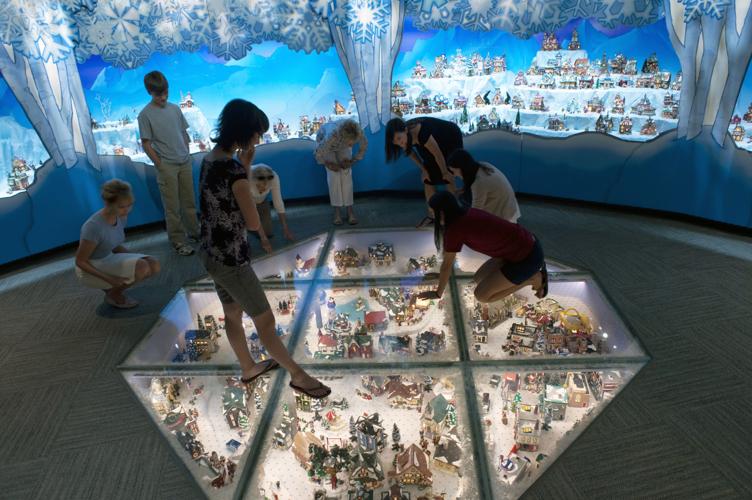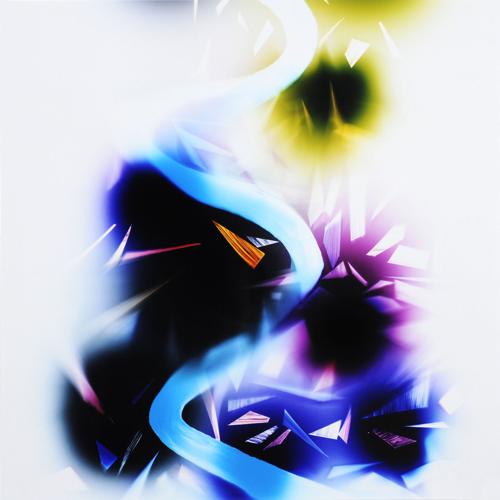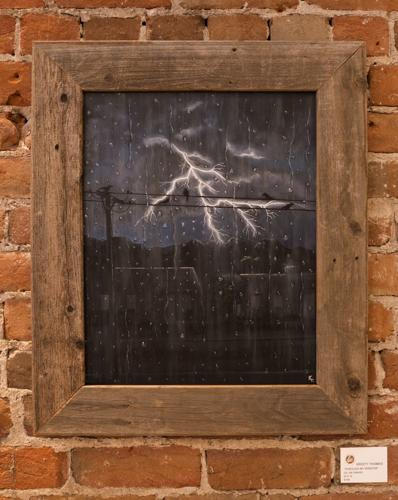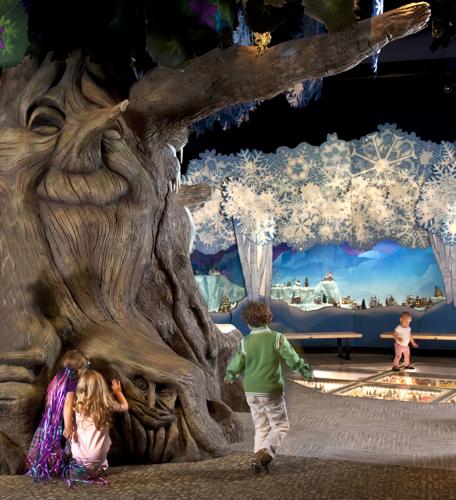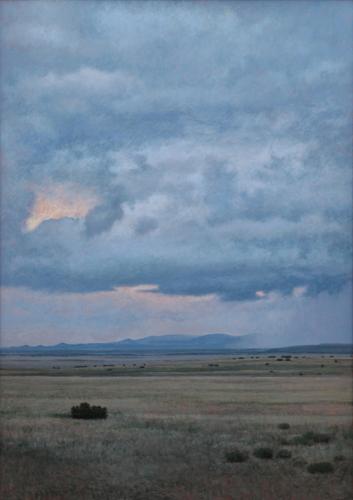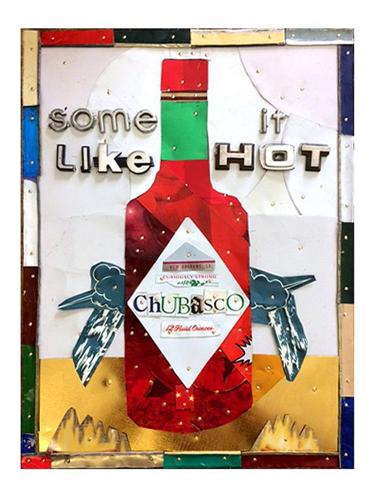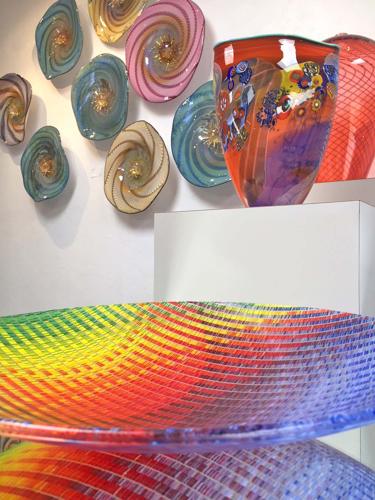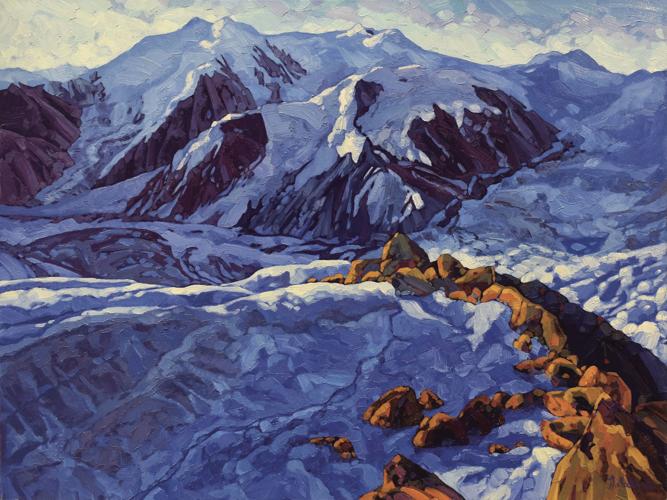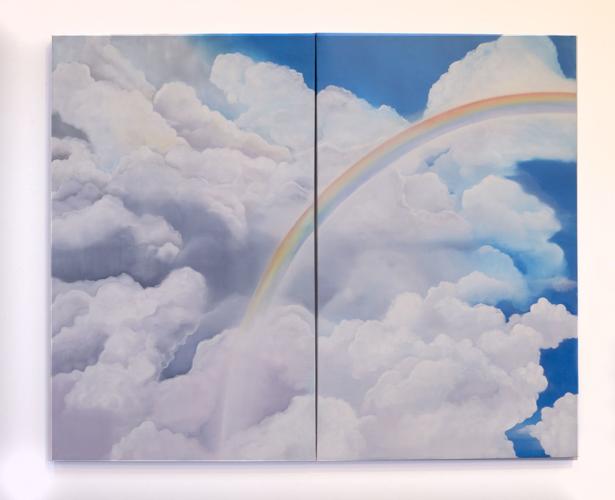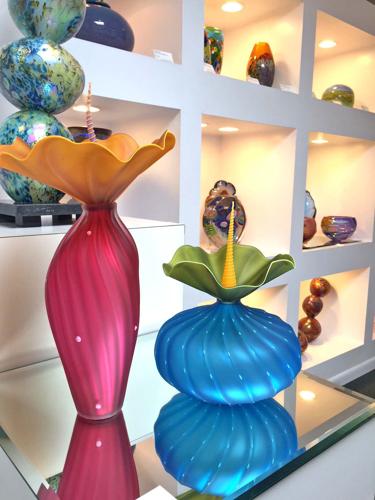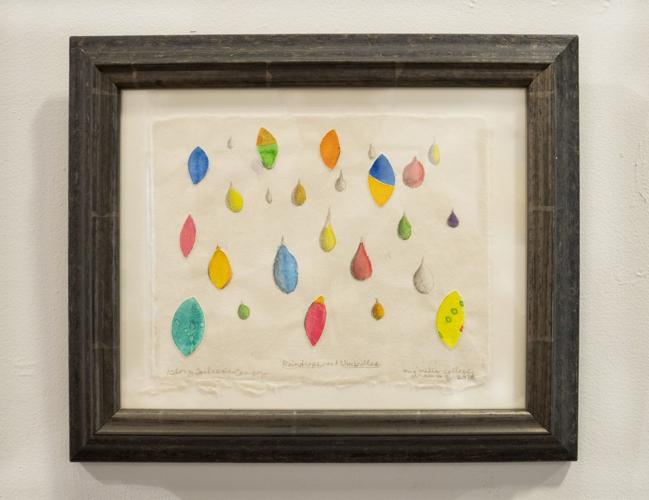The mercury is blasting past the century mark.
The sun is blazing down and the humidity is rapidly climbing up.
Tucson-area museums and galleries can be a reprieve from sidewalks hotter than a match head and are a chance to explore new ideas, challenge your perspectives, and appreciate (or not) the visions, talents and skills of others.
“It is definitely really, really hot, and a great time for indoor museums,” says Gina Compitello-Moore, marketing manager for the University of Arizona Museum of Art and the Center for Creative Photography.
“For the preservation of our collection, our galleries are climate controlled, so we are an excellent place to visit when it’s hot and sticky outside,” says Gentry Spronken, director of marketing and communications for the Mini Time Machine Museum of Miniatures.
Tucson’s eclectic museums and galleries are spaces where you are enveloped by cool, crisp air and arrays of classic and contemporary art by internationally known and local artists just about any style, form and medium imaginable.
Museums and galleries can be overwhelming and off-putting, especially to new visitors, so facilities such as the University of Arizona Museum of Art offer different entry points, says Compitello-Moore.
“We want them (all visitors) to know that they are welcome,” says Compitello-Moore. And that “you don’t have to love everything,” she adds.
Here is a look at handful of chill Tucson-area museums and galleries.
Center for Creative Photography
& The UA Museum of Art
The center and museum, major links in UA’s nine-museum chain, are across-the-street neighbors along pedestrian- and bicycle-only Olive Road at the center of the fine arts complex on the University of Arizona campus.
The academic art museum, 1031 N. Olive Road, originally the brainchild of then UA President John Schaefer and famed landscape photographer and environmentalist Ansel Adams, opened in 1975 in former retail space along North Park Avenue.
The center, 1030 N. Olive Road, now has 270 archival collections, which include some of the most recognizable names in 20th century North American photography, according to the CCP website.
There are more than 8 million archival objects including negatives, work prints, contact sheets, correspondence, audiovisual materials and memorabilia.
That’s in addition to more than 90,000 works by more than 2,200 photographers, a library and oral history collection.
Across the street at UAMA, Jackson Pollock, Georgia O’Keeffe and Rembrandt are just a few of the quickly come-to-mind artists in the collection of more than 5,000 paintings, sculptures and drawings, with an emphasis on European and American fine arts from Renaissance to today.

Among the items on display at the UA Museum of Art: Richard Slechta’s Inflection Point, 2016, Chromogenic Photogram.
For the younger crowd, Tucson high school student artists representing five school districts showcase varied points of view, technical skills and creativity in “Our Stories” exhibition. The show closes Sunday, Aug. 26.
It’s the last week for Tinkerlab, which is described as “the intersection of science and art.” A hands-on, maker space, kids ages 3 and older will play with colors and cross-reality tech tools through Thursday, Aug. 16.
- The CCP is open 9 a.m. to 4 p.m. Tuesday through Friday; 1 to 4 p.m. Saturdays. Admission is free. For more information, call 621-7968 or visit ccp.arizona.edu
- The UA Museum of Art is open 9 a.m. to 4 p.m. Tuesday through Friday; 9 a.m. to 5 p.m. Saturdays; noon to 5 p.m. Sundays. Admission is $8. For more information, call 621-7567 or visit artmuseum.arizona.edu
- Where to park: UA classes begin Aug. 20 so campus will soon be buzzing. It’s easiest to park in the Park Avenue Garage on the north side of Speedway. There is a fee for parking in the garage on weekdays. Use the pedestrian walkway to cross below Speedway, take the first stairway on the right after the exit and walk directly to the museum entrance. The center is right across the street.
- Where to eat: Head over to the University Main Gate Square at the intersection of Park Avenue and University Boulevard where the street is lined with bars and eateries.
Mark Sublette
Medicine Man Gallery
Founder J. Mark Sublette, a former physician, has filled Medicine Man Gallery with all things Southwest: American Indian art, jewelry and traditional crafts, cowboy art, wall and tabletop objects, and artistic and regional furniture.

Visitors to the Mark Sublette Medicine Man Gallery will find all things Southwest.
And works of Maynard Dixon.
Sublette is an authority on Maynard Dixon (1875-1946), a popular painter of the American West. The gallery, at 6872 E. Sunrise Drive, houses a museum, a permanent exhibit devoted to Dixon’s Arizona imagery circa 1900-1945, says Jaime Gould, gallery director.
“The museum has tried to capture the essence of Dixon, the artist as well as the individual, through not only his artwork but through his letters and poetry,” Sublette says on his Maynard Dixon website. Dixon’s easel, with plenty of drips of the artist’s iconic blue paint, is in the museum.
- The gallery’s summer hours are 10 a.m. to 5 p.m. Monday through Saturday. Admission is free. For more information, call 722-7798 or visit medicinemangallery.com
- Where to eat: Near the intersection of Sunrise Drive and North Kolb Road, you’ll find plenty of restaurants nearby. If you’re in the mood for something off the beaten culinary path, Inca’s Peruvian Cuisine, 6878 E. Sunrise Drive, is only a few steps away. You don’t have to move the car.
Mini Time Machine Museum of Miniatures
Tucked among the office buildings, shopping centers and housing west of North Swan Road near East Camp Lowell Drive, the museum is packed with imaginary, magical worlds, antique buildings, and pieces of history and contemporary life in itsy-bitsy, teeny-weeny scale.
There’s usually plenty of head-scratching and “how’d they do that” comments when viewing the detailed, realistic buildings, landscapes, creatures, and characters portrayed as multimedia miniatures.
The museum’s permanent collections are split into three main areas; the Enchanted Realm, History Gallery and Exploring the World.

The Enchanted Realm is one of three main areas at the Mini Time Machine Museum of Miniatures. There’s usually plenty of head-scratching and many “How’d they do that?” comments at the museum.
In “Scenes from Salvaged Scraps: Debbie Gill’s Miniature Rooms” the Mesa-based artist uses only recycled materials to create miniature rooms that draw upon her love of interior design and childhood memories, says Spronken. The temporary exhibit runs through Aug. 26.
For the younger set, there is the Kids Create Family Fun Program from noon to 3 p.m. on Sept. 8 — regularly offered on the second Saturday of the month — and Tiny Tales for Tots is from 10:30 to 11 a.m. on Wednesday, Aug. 15. — regularly held on the third Wednesday of the month.
- The museum, 4455 E. Camp Lowell Drive, is open from 9 a.m. to 4 p.m. Tuesday through Saturday; noon to 4 p.m. Sundays. Admission is $9. For more information, call 881-0606 or visit theminitimemachine.org
- Where to eat: The museum is near the bustling intersections of Swan and Camp Lowell roads and Swan and Fort Lowell roads and you’ll find plenty of spots to eat. Tucson Coffee Roasters, 3225 N. Swan Road, near the Bashas’ grocery store, has a variety of fancy (and plain) coffee and cool drinks.
Philabaum Glass Studio and Gallery
It’s too hot for fiery hot blowpipes and dripping molten glass in a furnace with dancing orange flames, but that’s no reason to skip the Philabaum Glass Studio and Gallery, the only all-glass gallery in Southern Arizona.
“The gallery is nice and cool, but our colors are warm, and really evoke the feelings of summer — without heating you up,” says Alison Harvey, gallery manager. “I don’t think that a lot of people realize what a special place this is.”
The gallery, 711 S. Sixth Ave., shows the work of Tom Philabaum, who has been making glass art for almost five decades, as well as the work of about 30 other glass artists showing pieces and styles that include jewelry, casting, fusing and lamp working.

The Philabaum Glass Studio and Gallery is the only all-glass gallery in Southern Arizona.
There will not be any glass blowing until Sept. 5, says Harvey.
Founder and primary artist Philabaum planned to retire from the shop earlier this year, but he has delayed that. There will be glass blowing until January 2019. Then the glass-blowing studio will close, and the gallery will remain open indefinitely to show Philabaum’s work, including one-of-a-kind sculptures and glass paintings as well as the work of other artists.
- The gallery’s summer hours are 11 a.m. to 4 p.m. Tuesday through Saturday. Admission is free. For more information, call 884-7404 or visit philabaumglass.com
- Where to eat: The Philabaum gallery is located at Five Points, the goofy intersection at Sixth Avenue, Stone Avenue, and 18th Street, about seven blocks south of central downtown. Five Points Market and Restaurant, 756 S. Stone Ave., is a popular spot for this up-and-coming area.
Raices Taller 222 Art Gallery and Workshop
Anxiously waiting for the monsoon rain to break the heat and wash the desert (and our cars) is a common, albeit sometimes frustrating, Tucson summer activity.
Raises Taller’s multimedia “Chubasco,” the gallery’s annual homage to the monsoon, showcases the refreshing joy, elusiveness, fickleness, politics and drama of monsoon sprinkles, gully-washers and lightning.
The Tucson-centric show is a favorite of the Latino-based contemporary nonprofit cooperative art gallery and workshop, which focuses on the art of traditional and historical cultures of the area. “Chubasco: A Monsoon Exhibition” continues through Saturday, Sept. 1.
Raices (roots) and Taller (workshop) is the inspiration of the founding members, Juan Enriquez and Jorge Arteaga, who needed studio space to pursue their artwork.

Raises Taller’s multimedia “Chubasco” is the gallery’s annual homage to the monsoon.
No big chill here: The gallery, 218 E. Sixth St., does not have air conditioning, but the swamp cooler in the rustic brick building in the Downtown Historic Warehouse District keeps the space cool.
- The gallery is open 1 to 5 p.m. Fridays and Saturdays and by appointment. It will be open 6 to 9 p.m. on Sept. 1 for the exhibit’s closing celebration and poetry reading. Admission is free. For more information, call 881-5335 or visit raicestaller222.com
- Where to eat: Fourth Avenue, lined with places to eat and drink, is to the west, and Crooked Teeth Brewing Company, 228 E. Sixth St., in a 1950s garage, is steps a way.
Tucson Museum of Art
and Historic Block
The Tucson Museum of Art museum and 19th century houses surround a landscaped central plaza and patio and stretch over a full block in El Presidio Historic District of downtown.
The museum, 140 N. Main Street, showcases traveling collections and exhibits curated from its permanent collection that includes Latin American, Asian, Western and Native American, American folk, contemporary and European art.
You’ll find plenty of recognizable names among the galleries. Expect artists such as Henri Matisse, Pablo Picasso and Henri de Toulouse-Lautrec in the Palice Gallery of European Art.
The museum has a noted collection of Pre-Columbian and Spanish Colonial art — textiles, objects, jewelry ranging from 1600 BCE to the 19th century — on display in the Palice Gallery of Latin American Art.
TMA’s Arizona Biennial — 84 works of art from 70 Arizona artists in a range of mediums including painting, sculpture, works on paper, photography, video and installation art — runs through Sept. 16.
And there’s shopping. The TMA gift shop has art, of course, as well as books, jewelry, scarves, knickknacks, toys and educational materials.
The first Thursday of each month from 5 to 8 p.m. is a free chance to make and explore art. There’s a cash bar available, so it is geared more toward an adult crowd.
For the younger crowd, kid-focused activities and music are offered the second Sunday of each month with free admission for Arizona and Sonora, Mexico residents.
- TMA is open 10 a.m. to 5 p.m. Tuesday through Sunday. Admission is $12. For more information, call 624-2333 or visit TucsonMuseumofArt.org
- Where to park: The museum is at West Alameda Street and North Main Avenue. Park free in the museum’s lot on West Washington Street.
- Where to eat: Café à la C’Art, 150 N. Main Ave., is in the Hiram Stevens house on the TMA campus and serves a full menu. Plan on having one of the luscious desserts.


